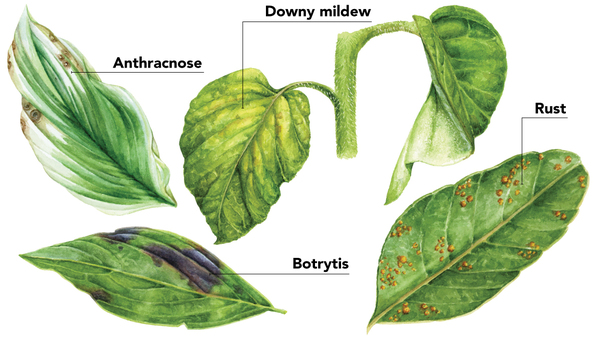
Fuzz is cute on bunnies and peaches; it isn’t so cute on your plants-at least not when it’s preceded by slime. These are two nasty signs that you have gray mold. The mold usually appears when temperatures start to cool. The situation is more significant for ornamentals than edibles, but popular vegetables—such as tomatoes, peppers, potatoes, cabbages, broccoli, and cauliflower—are all susceptible. Greenhouses often provide the perfect environment for an outbreak, making it a common problem in greenhouse-grown crops during winter. Periodically, this disease shows up in the garden, especially under wet and shady conditions.
It likes humidity
The most common gray mold is caused by the fungus Botrytis cinerea and is often referred to as Botrytis blight (a different species, Botrytis paeoniae, is what commonly afflicts peonies). The disease can spread rapidly by means of microscopic spores produced by the fungus, which can hitch a ride on air currents and splashing water. Spores are ever present in greenhouses, creating a constant potential for disease outbreaks. The fungus usually gets started on weak or aging plants or plant parts, penetrating the plant directly or entering through wounds created by the taking of cuttings or the removal of leaves. Standing water on plants or the presence of high humidity, even for just a few hours, creates an ideal disease environment. Plants that succumb to other problems also become havens for the gray-mold fungus. Gray mold can infect plants at any time, and it can be a serious problem for crops kept in storage for long periods of time, such as onions and corms of gladiolus.
Watch out for the fuzz
Gray mold gets its name from the gray color of the spores that are produced on leaves, flowers, or stems. This gray fuzz can easily be seen on aging flowers and, to a lesser extent, on leaves and stems. Flower sepals and petals are often the first parts of the flower to show evidence of the fungus. Before the gray fuzz appears, plant tissue often develops a darkened water-soaked or greasy appearance. Soft and slimy areas can develop on plant stems, resulting in a total collapse of the plant. Soft-rot symptoms are common on corms and bulbs of various ornamentals and vegetables. The fungus has the ability to survive adverse weather conditions in dead-plant material that may remain on the floors or benches in a greenhouse or as sclerotia (small hard structures) in the soil. This survival mechanism makes disease management a real challenge to gardeners. In the field, gray mold can run rampant on strawberries, causing blossom or fruit rot. Infection can even spread down the strawberry plant, causing a damping-off of the plant crown.
-Stephen Vann is an assistant professor and extension urban plant pathologist at the University of Arkansas at Little Rock.
From Fine Gardening issue #136, page 74

















Comments
Did I miss something? It sounds like there is nothing you can do other than inspect plants carefully before purchasing them from a greenhouse.
Log in or create an account to post a comment.
Sign up Log in